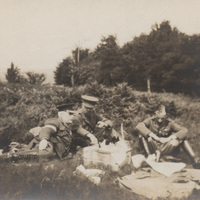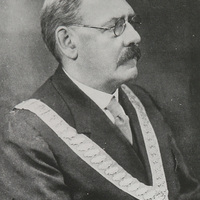University College Galway Staff and the War / Foireann an Choláiste agus an Cogadh
The president of the College in 1914 was Alexander Anderson, Professor of Physics and fellow of Sidney Sussex College, Cambridge.
A staunch Unionist with origins among the Presbyterian community in Antrim, President Anderson encouraged students in the University to put their studies on hold and join the war effort, and he insisted that all applications for commissions in the military from students be handed to him personally for processing.
In 1914 UCG was governed by a twenty-five member governing body consisting of senior Professors, members of both the Anglican and Catholic Church hierarchies, and elected graduates. The academic staff comprised twenty-five professors, six lecturers and eight demonstrators and assistants who lectured in seven faculties: Arts, Celtic, Science, Law, Medicine, Engineering and Commerce. On the outbreak of the conflict academic staff had differing political viewpoints and attitudes towards the war, causing profound personal and political divisions. A significant number of professors enlisted for the war, despite their age. Professors Ralph Bodkin Mahon and Conor O’Malley served with the Royal Army Medical Corps (RAMC). Professor Kinkead’s son, Capt. Richard Kinkead, also RAMC, was killed during the First Battle of Ypres in October 1914. Professor of Engineering Frank Sharman Rishworth fought alongside his two brothers. President Anderson’s son, Alexander, serving with the Royal Flying Corps, was wounded and taken prisoner at the Somme in 1916. Transported to Germany, young Anderson ended the war in a POW camp at Stralsund on the Baltic coast.
Like nationalist Ireland more generally, Galway and UCG reflected the split in 1914 between the National Volunteers who supported Redmond’s pro-war stance and those who opposed it. Galway opponents re-founded the Irish Volunteers in the town in late 1914, with the participation of seven professors of the university: Valentine Steinberger, Max Drennan, Tomás Ó Máille, Joseph Pye, Thomas Walsh, Seághan MacÉnrí and Michael Power were all seated on the organising platform. The Irish Volunteers rejected John Redmond’s appeal for Irishmen to enlist in the British military and were heavily infiltrated by the Fenian secret society, the Irish Republican Brotherhood. Professors Mac Énrí and Ó Máille argued publicly against any Irish involvement in the European conflict and urged students not to enlist in the military.
Xenophobia, spy-mania and detention of enemy civilians as ‘aliens’ featured across combatant nations during World War One, with German civilians interned in Templemore, Co Tipperary, and later on the Isle of Man. Professor Steinberger, as a German, and UCG republicans, formed an ‘enemy within’ for the Galway Express newspaper which thundered that:
A number of German born spies are hovering round Galway at the present time. May we suggest to the police and other authorities protecting the British interests that any persons found undermining the cause of England, France and Russia, be at once placed in a position that his (or her venom) will be permanently extracted. This is no time for sentiment. We are fighting to the death.
Alongside staff, a number of former students played prominent roles in the war effort. Sir Alfred Keogh (1857-1936) was a native of Dublin and educated at Queen’s College, Galway. He joined the Army Medical service in 1880 as a surgeon. Promoted to the rank of surgeon-major at the outbreak of the Boer War in 1898, his reputation soared during the ensuing conflict. In 1905 he was promoted to the position of director-general of the Army Medical School. On the outbreak of the war in 1914, he took control of the Red Cross Committee which co-ordinated voluntary medical aid in France and Flanders. His wartime work was regarded as outstanding and he received many international awards including the French Légion d’honneur.
Sir Peter Freyer (1851–1921), surgeon, was born in Sellerna, a village eight miles from Clifden, Connemara, the eldest son of Samuel Freyer, a large farmer. He was educated at the Erasmus Smith College (Galway Grammar School), and this university. Freyer gained first place in the Indian Medical Service (IMS) examination of 1875, becoming Surgeon-Major and Lieutenant Colonel by 1895. He rejoined the IMS in 1914, but served in Britain at the Royal Pavilion Indian Hospital in Brighton and later at Queen Alexandra Military Hospital London. A specialist in urology, Freyer was made a Knight’s Commander of the Order of the Bath in 1917.

UCG alumnus and eminent military surgeon Sir Peter Freyer, pictured here at Solingen in Germany in August 1919 with the occupying British Army of the Rhine
Foireann an Choláiste agus an Cogadh
Ba é Alexander Anderson, Ollamh le Fisic agus comhalta de Sidney Sussex College, Cambridge, a bhí ina Uachtarán ar an gColáiste sa bhliain 1914.
B’Aontachtaí diongbháilte a raibh baint aige leis an bpobal Preispitéireach i gCo. Aontroma a bhí san Uachtarán Anderson agus spreag sé mic léinn na hOllscoile chun a gcuid staidéar a chur ar leataobh agus a bheith páirteach sa chogadh. D’éiligh sé go gcuirfí gach iarratas ó mhic léinn ar choimisiúnú san arm faoina bhráid féin go pearsanta le próiseáil.
Sa bhliain 1914 bhí Coláiste na hOllscoile, Gaillimh, faoi riail údarás ar a raibh cúigear ball is fiche, ina measc, ollúna sinsearacha, baill chliarlathas na hEaglaise Anglacánaí agus na hEaglaise Caitlicí agus céimithe tofa. Ar an bhfoireann acadúil bhí cúigear Ollúna is fiche, seisear léachtóirí agus ochtar taispeántóirí agus cúntóirí a bhí ag léachtóireacht i seacht ndámh; Dána, an Léann Ceilteach, Eolaíocht, Dlí, Leigheas, Innealtóireacht agus Tráchtáil. Nuair a thosaigh an choimhlint bhí tuairimí polaitíochta thar a bheith éagsúil ag an bhfoireann acadúil agus dearcaí difriúla acu ar an gcogadh, rud a chruthaigh deighiltí ollmhóra pearsanta agus polaitíochta. Liostáil líon suntasach ollúna don chogadh, in ainneoin an aois a bhí acu. Bhí na hOllúna Frank Sharman Rishworth, Ralf Bodkin Mahon agus Conor O’Malley i gCór Liachta Arm na Breataine. Bhain mac an Ollaimh Kinkead, an Captaen Richard Kinkead, leis an gCór Liachta chomh maith agus maraíodh é le linn chéad chath Ypres i nDeireadh Fómhair 1914. Throid Frank Sharman Rishworth, Ollamh le hInnealtóireacht, le taobh beirt dheartháir. Throid mac an Uachtaráin Anderson, Alexander, leis an gCór Eitilte Ríoga. Gortaíodh é agus gabhadh é ag an Somme i 1916. Cuireadh Alexander óg go dtí an Ghearmáin agus faoi dheireadh an chogaidh bhí sé i gcampa do Phríosúnaigh Chogaidh i Stralsund ar chósta na Bailtise.
Ar nós na hÉireann i gcoitinne, léirigh Gaillimh agus Coláiste na hOllscoile, Gaillimh, an deighilt i 1914 idir na hÓglaigh Náisiúnta a thaobhaigh le seasamh Redmond i bhfábhar an chogaidh agus iad siúd a bhí ina choinne. Athbhunaíodh Óglaigh na hÉireann i mbaile na Gaillimhe ag deireadh 1914, agus ghlac seachtar ollúna de chuid na hollscoile páirt san athbhunú seo agus bhí siad go léir ar an ardán eagraithe; ba iad sin Valentine Steinberger, Max Drennan, Tomás Ó Máille, Joseph Pye, Thomas Walsh, Seághan MacÉnrí agus Michael Power. Dhiúltaigh Óglaigh na hÉireann achomharc John Redmond d’fhir Éireannacha liostáil in arm na Breataine agus bhí siad ionsíothláite go láidir ag cumann rúnda na bhFíníneach, Bráithreachas Phoblacht na hÉireann. Bhí na hollúna MacÉnrí agus Ó Máille ag argóint go poiblí i gcoinne aon rannpháirtíocht ó mhuintir na hÉireann sa choimhlint Eorpach agus mhol siad do mhic léinn gan liostáil san arm.
Bhí seineafóibe agus imní faoin spiaireacht go láidir agus bhí sibhialtaigh naimhdeacha á gcoinneáil mar ‘choimhthígh’ ar fud na náisiúin a bhí i mbun comhraic le linn an Chéad Chogaidh Domhanda. Bhí sibhialtaigh na Gearmáine imtheorannaithe sa Teampall Mór, Co. Thiobraid Árann, agus níos deireanaí ar Oileán Mhanann. Dar leis an Galway Express, ba ‘namhaid laistigh’ an tOllamh Steinberger, mar Ghearmánach, agus poblachtaigh Choláiste na hOllscoile. D’áitigh an nuachtán:
A number of German born spies are hovering round Galway at the present time. May we suggest to the police and other authorities protecting the British interests that any persons found undermining the cause of England, France and Russia, be at once placed in a position that his (or her) venom will be permanently extracted. This is no time for sentiment. We are fighting to the death.
Mar aon le comhaltaí foirne, bhí róil lárnacha ag roinnt iarmhac léinn sa chogadh chomh maith. B’as Baile Átha Cliath do Sir Alfred Keogh (1857-1936), agus fuair sé a chuid oideachais i gColáiste na Banríona, Gaillimh. Chuaigh sé ag obair le seirbhís leighis an Airm sa bhliain 1880 mar mháinlia. Fuair sé ardú céime agus rinneadh maor-mháinlia de ag tús Chogadh na mBórach sa bhliain 1898 agus mhéadaigh a cháil le linn na coimhlinte a lean. Sa bhliain 1905, ceapadh é ina ardstiúrthóir ar Scoil Leighis an Airm. Ag tús an chogaidh i 1914, ghlac sé ceannas ar Choiste na Croise Deirge a chomhordaigh cúnamh deonach leighis sa Fhrainc agus i bhFlóndras. Measadh go raibh a chuid oibre le linn an chogaidh thar barr agus is iomaí gradam idirnáisiúnta a fuair sé, Légion d’honneur na Fraince ina measc.
Rugadh Sir Peter Freyer (1851–1921), máinlia, i Sailearna, baile beag ocht míle as an gClochán, Conamara. Ba é an mac ba shine é ag Samuel Freyer a bhí ina fheirmeoir mór. Fuair sé a chuid oideachais i gColáiste Erasmus Smith (Scoil Ghramadaí na Gaillimhe), agus san Ollscoil seo. Bhain Freyer an chéad áit amach sa scrúdú do Sheirbhís Leighis na hIndia i 1875. Rinneadh maor-mháinlia de i 1887 agus rinneadh leifteanantchoirnéal de i 1895; chuaigh sé ar scor ón tseirbhís i 1896. Chuaigh sé ar ais ag obair le Seirbhís Leighis na hIndia nuair a bhris an Chéad Chogadh Domhanda amach. Bhí sé san Ospidéal Indiach sa Phailliún Ríoga i mBrighton agus ina dhiaidh sin bhí sé fostaithe in Ospidéal Míleata na Banríona Alexandra i Londain. Speisialtóir san úireolaíocht ab ea é, agus agus rinneadh ‘Knight’s Commander of the Order of the Bath’ de i 1917.


